FORD ESCAPE HYBRID 2011 2.G Owners Manual
Manufacturer: FORD, Model Year: 2011, Model line: ESCAPE HYBRID, Model: FORD ESCAPE HYBRID 2011 2.GPages: 363, PDF Size: 3.38 MB
Page 121 of 363
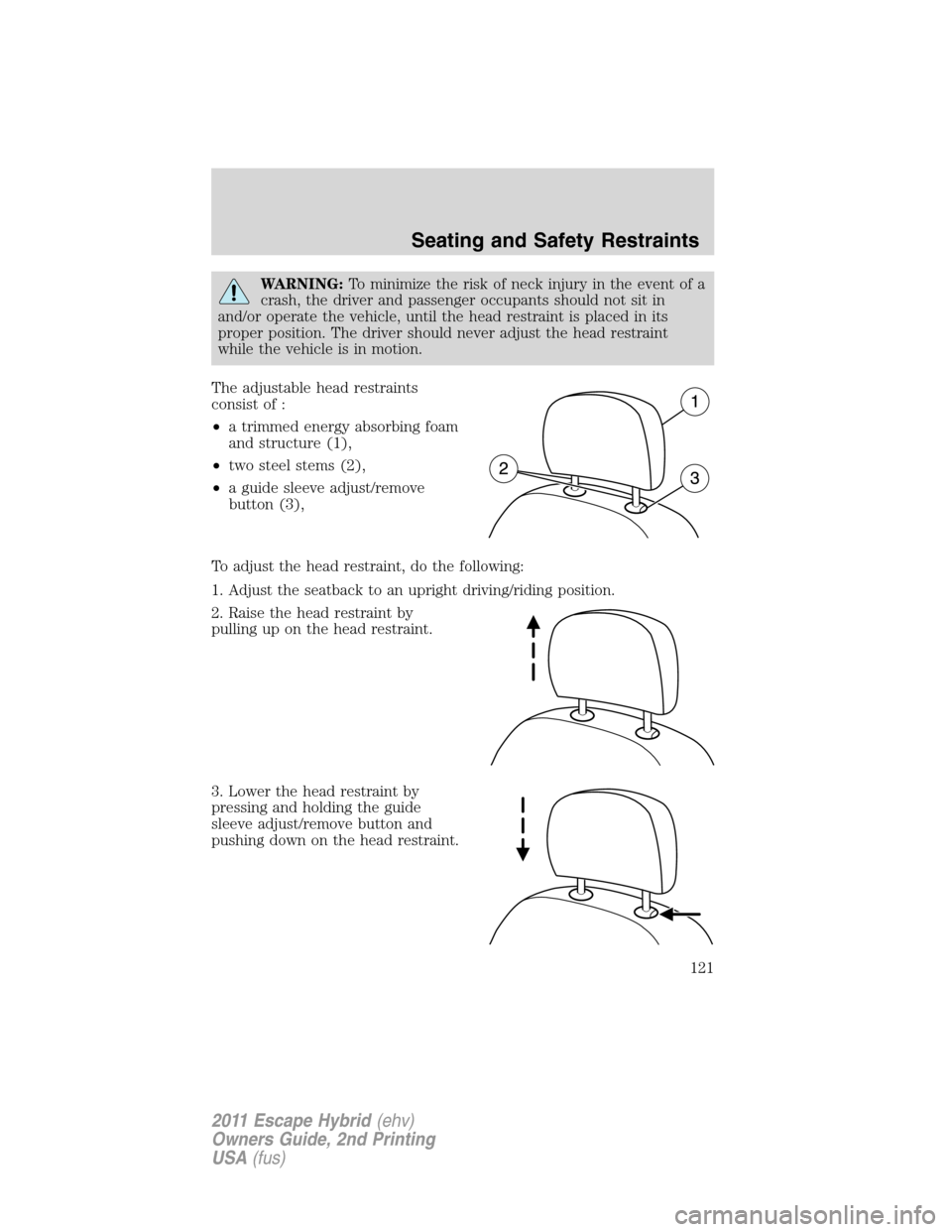
WARNING:To minimize the risk of neck injury in the event of a
crash, the driver and passenger occupants should not sit in
and/or operate the vehicle, until the head restraint is placed in its
proper position. The driver should never adjust the head restraint
while the vehicle is in motion.
The adjustable head restraints
consist of :
•a trimmed energy absorbing foam
and structure (1),
•two steel stems (2),
•a guide sleeve adjust/remove
button (3),
To adjust the head restraint, do the following:
1. Adjust the seatback to an upright driving/riding position.
2. Raise the head restraint by
pulling up on the head restraint.
3. Lower the head restraint by
pressing and holding the guide
sleeve adjust/remove button and
pushing down on the head restraint.
Seating and Safety Restraints
121
2011 Escape Hybrid(ehv)
Owners Guide, 2nd Printing
USA(fus)
Page 122 of 363
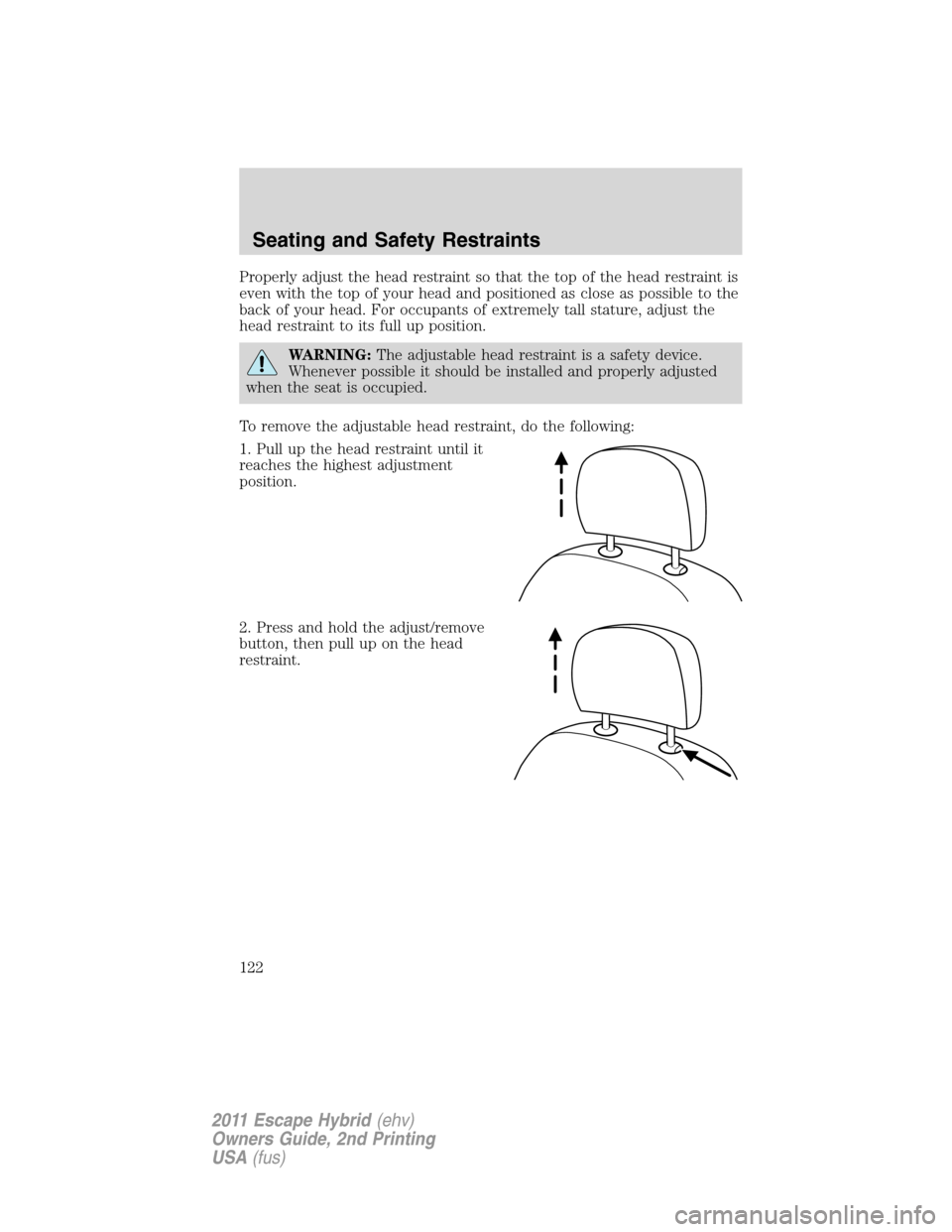
Properly adjust the head restraint so that the top of the head restraint is
even with the top of your head and positioned as close as possible to the
back of your head. For occupants of extremely tall stature, adjust the
head restraint to its full up position.
WARNING:The adjustable head restraint is a safety device.
Whenever possible it should be installed and properly adjusted
when the seat is occupied.
To remove the adjustable head restraint, do the following:
1. Pull up the head restraint until it
reaches the highest adjustment
position.
2. Press and hold the adjust/remove
button, then pull up on the head
restraint.
Seating and Safety Restraints
122
2011 Escape Hybrid(ehv)
Owners Guide, 2nd Printing
USA(fus)
Page 123 of 363
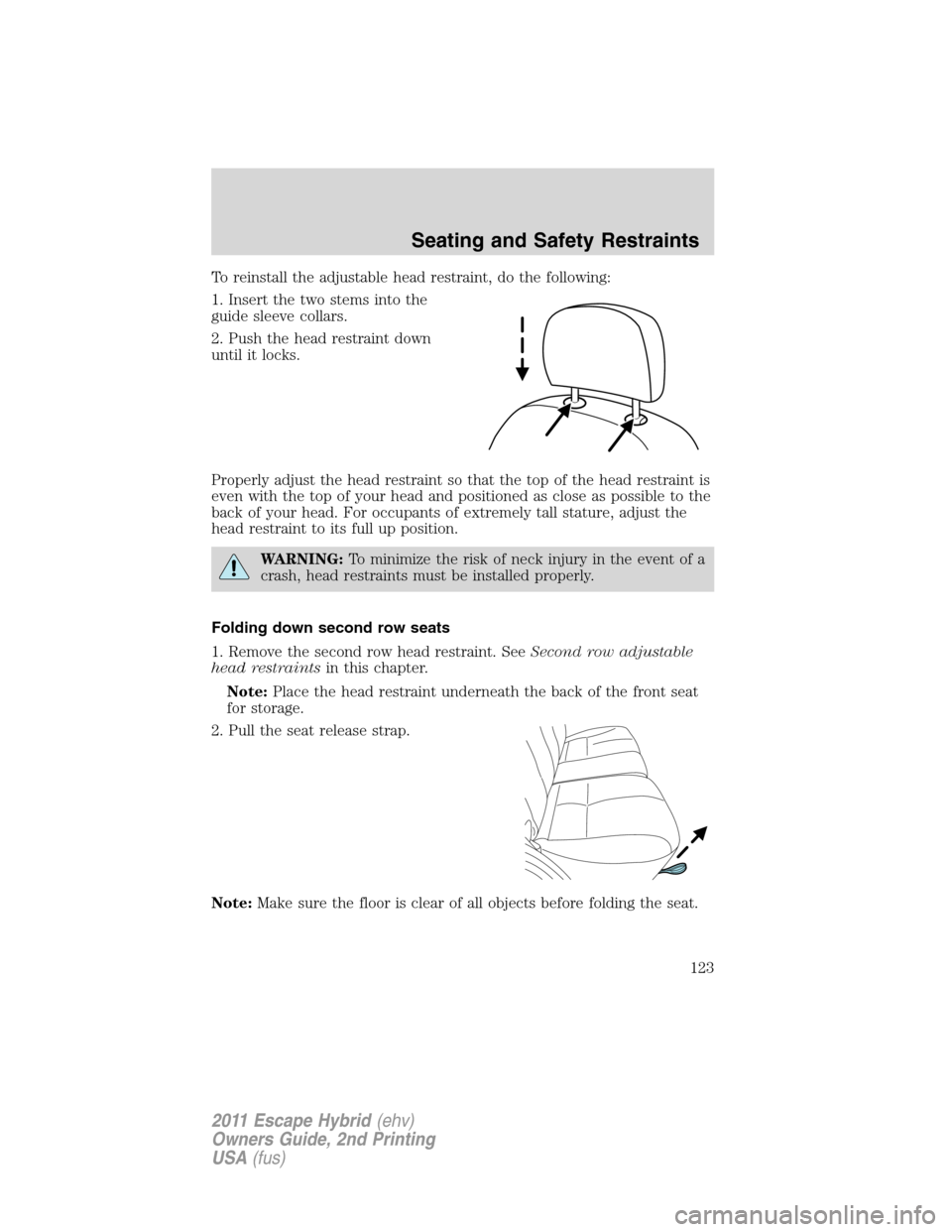
To reinstall the adjustable head restraint, do the following:
1. Insert the two stems into the
guide sleeve collars.
2. Push the head restraint down
until it locks.
Properly adjust the head restraint so that the top of the head restraint is
even with the top of your head and positioned as close as possible to the
back of your head. For occupants of extremely tall stature, adjust the
head restraint to its full up position.
WARNING:To minimize the risk of neck injury in the event of a
crash, head restraints must be installed properly.
Folding down second row seats
1. Remove the second row head restraint. SeeSecond row adjustable
head restraintsin this chapter.
Note:Place the head restraint underneath the back of the front seat
for storage.
2. Pull the seat release strap.
Note:Make sure the floor is clear of all objects before folding the seat.
Seating and Safety Restraints
123
2011 Escape Hybrid(ehv)
Owners Guide, 2nd Printing
USA(fus)
Page 124 of 363
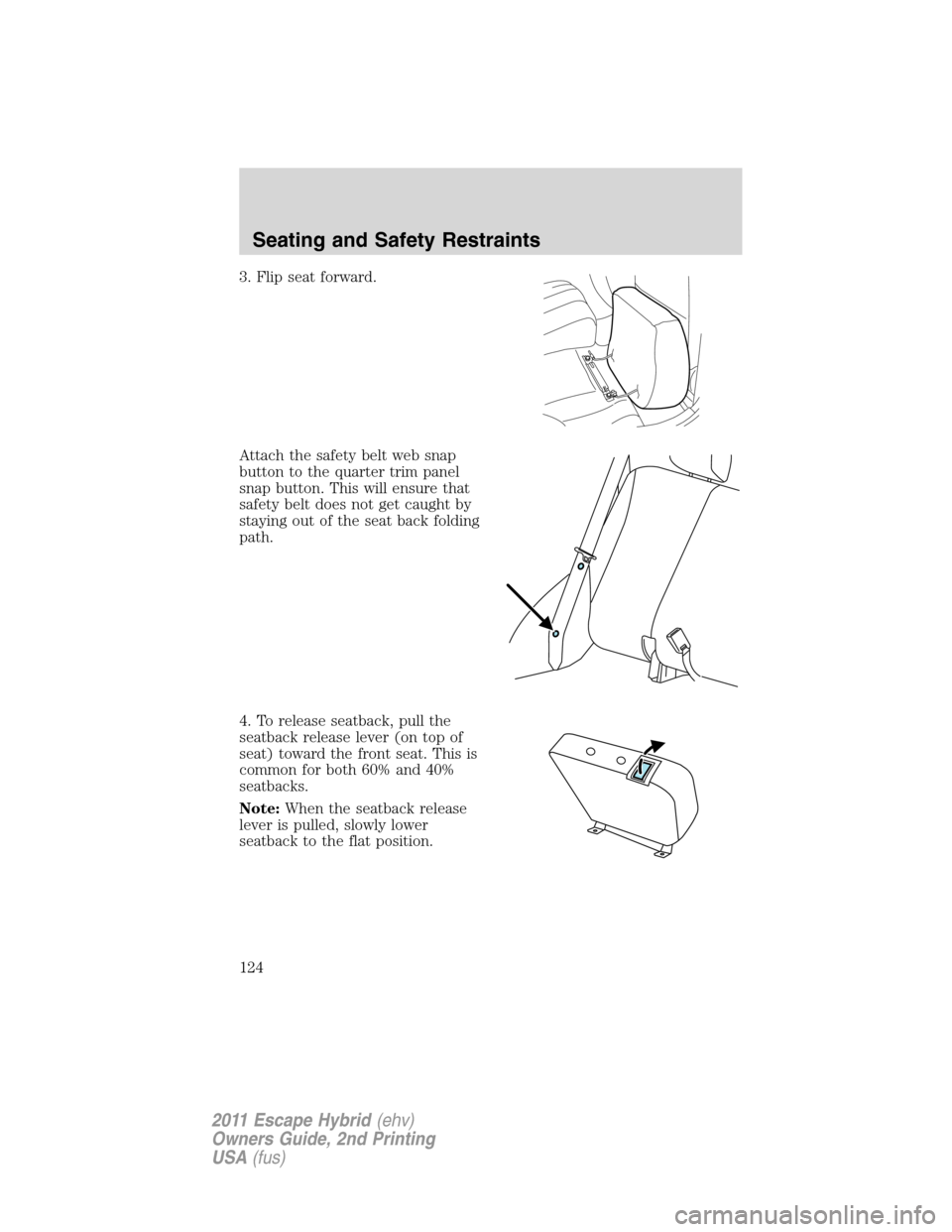
3. Flip seat forward.
Attach the safety belt web snap
button to the quarter trim panel
snap button. This will ensure that
safety belt does not get caught by
staying out of the seat back folding
path.
4. To release seatback, pull the
seatback release lever (on top of
seat) toward the front seat. This is
common for both 60% and 40%
seatbacks.
Note:When the seatback release
lever is pulled, slowly lower
seatback to the flat position.
Seating and Safety Restraints
124
2011 Escape Hybrid(ehv)
Owners Guide, 2nd Printing
USA(fus)
Page 125 of 363
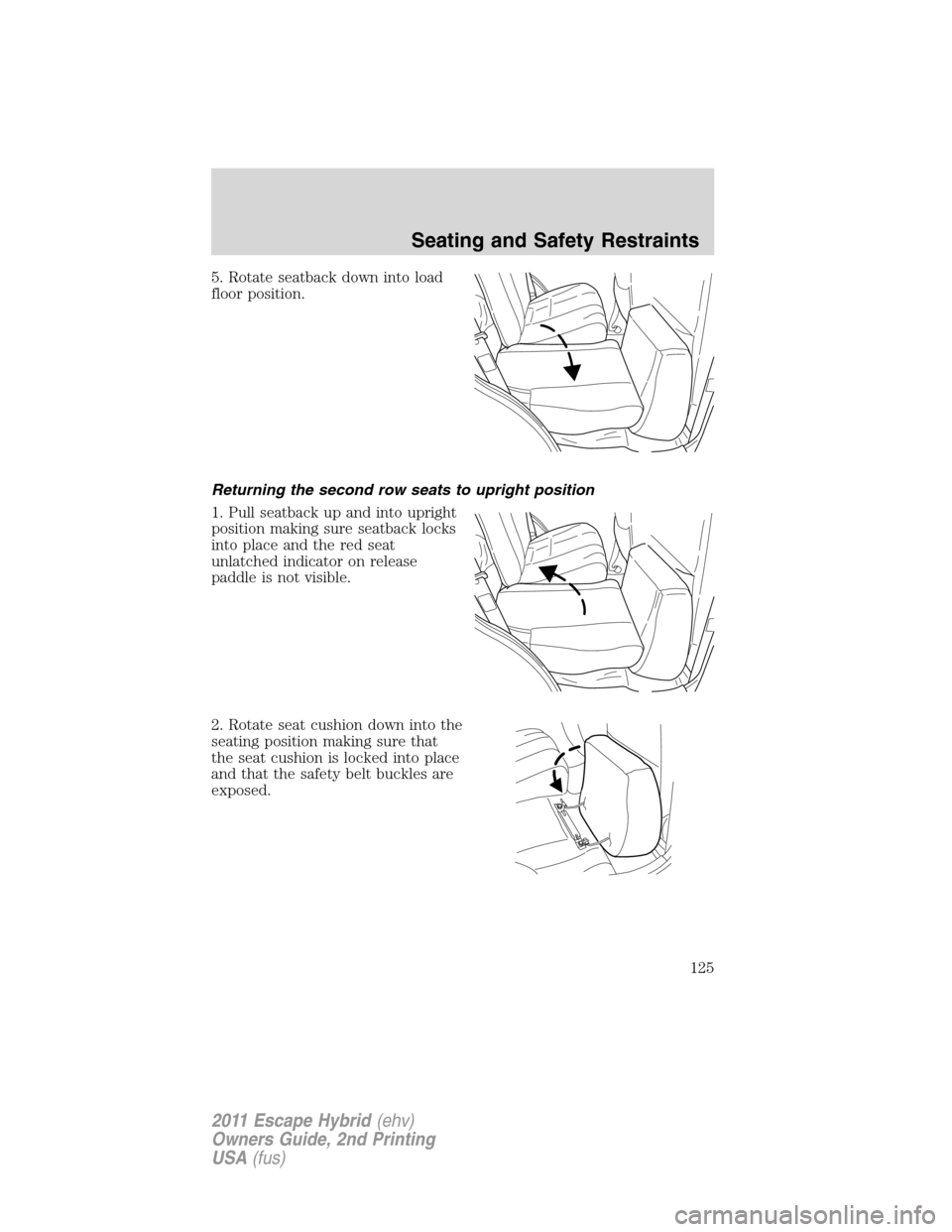
5. Rotate seatback down into load
floor position.
Returning the second row seats to upright position
1. Pull seatback up and into upright
position making sure seatback locks
into place and the red seat
unlatched indicator on release
paddle is not visible.
2. Rotate seat cushion down into the
seating position making sure that
the seat cushion is locked into place
and that the safety belt buckles are
exposed.
Seating and Safety Restraints
125
2011 Escape Hybrid(ehv)
Owners Guide, 2nd Printing
USA(fus)
Page 126 of 363
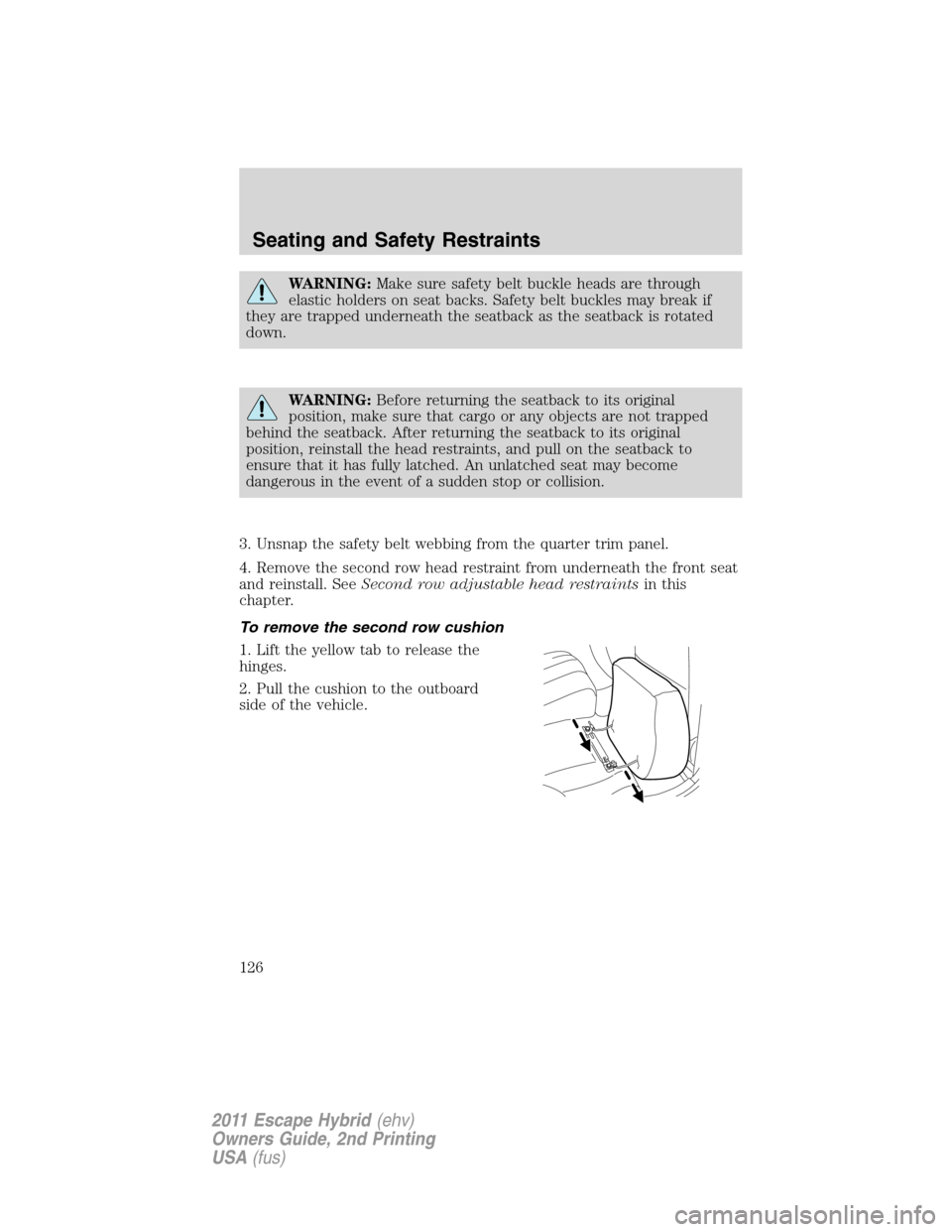
WARNING:Make sure safety belt buckle heads are through
elastic holders on seat backs. Safety belt buckles may break if
they are trapped underneath the seatback as the seatback is rotated
down.
WARNING:Before returning the seatback to its original
position, make sure that cargo or any objects are not trapped
behind the seatback. After returning the seatback to its original
position, reinstall the head restraints, and pull on the seatback to
ensure that it has fully latched. An unlatched seat may become
dangerous in the event of a sudden stop or collision.
3. Unsnap the safety belt webbing from the quarter trim panel.
4. Remove the second row head restraint from underneath the front seat
and reinstall. SeeSecond row adjustable head restraintsin this
chapter.
To remove the second row cushion
1. Lift the yellow tab to release the
hinges.
2. Pull the cushion to the outboard
side of the vehicle.
Seating and Safety Restraints
126
2011 Escape Hybrid(ehv)
Owners Guide, 2nd Printing
USA(fus)
Page 127 of 363
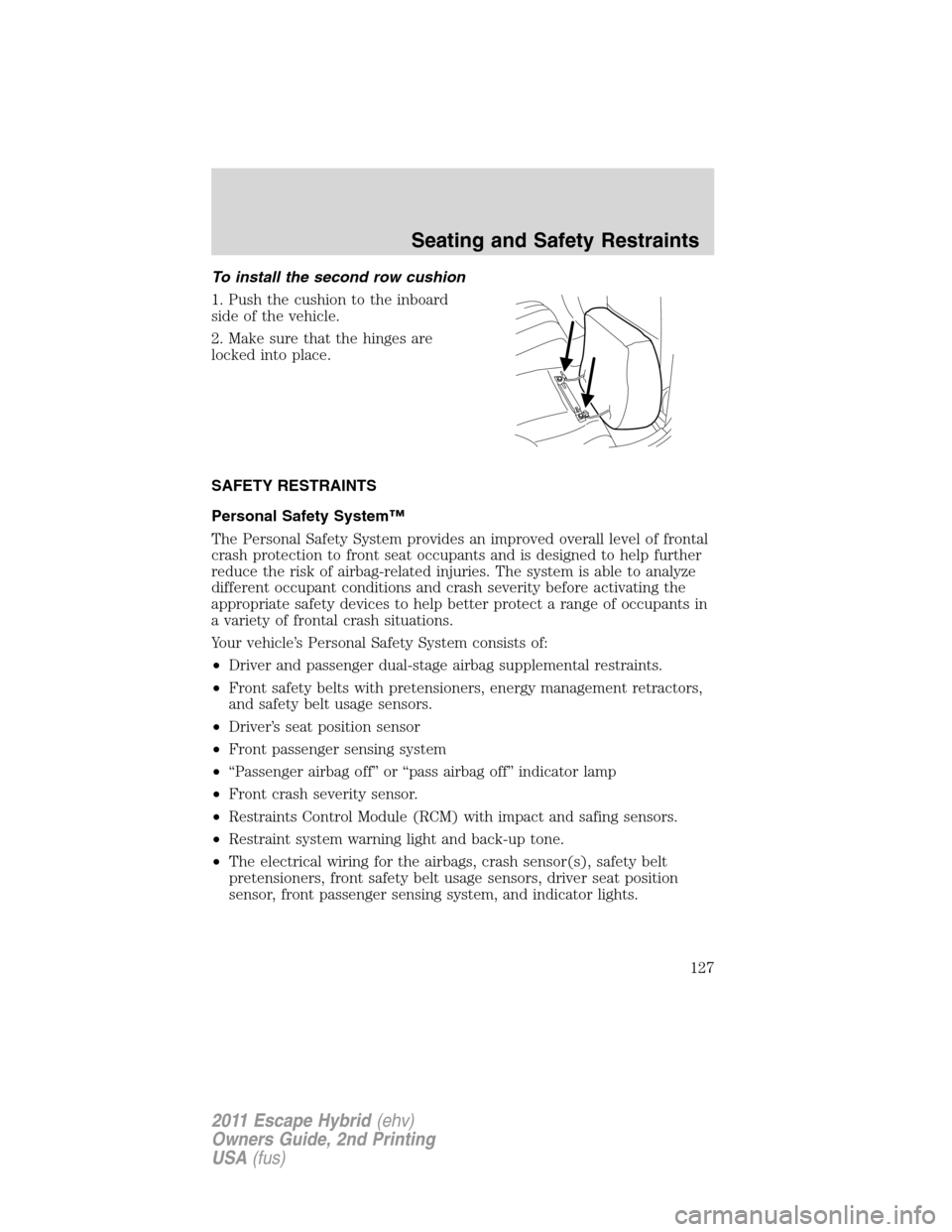
To install the second row cushion
1. Push the cushion to the inboard
side of the vehicle.
2. Make sure that the hinges are
locked into place.
SAFETY RESTRAINTS
Personal Safety System™
The Personal Safety System provides an improved overall level of frontal
crash protection to front seat occupants and is designed to help further
reduce the risk of airbag-related injuries. The system is able to analyze
different occupant conditions and crash severity before activating the
appropriate safety devices to help better protect a range of occupants in
a variety of frontal crash situations.
Your vehicle’s Personal Safety System consists of:
•Driver and passenger dual-stage airbag supplemental restraints.
•Front safety belts with pretensioners, energy management retractors,
and safety belt usage sensors.
•Driver’s seat position sensor
•Front passenger sensing system
•“Passenger airbag off” or “pass airbag off” indicator lamp
•Front crash severity sensor.
•Restraints Control Module (RCM) with impact and safing sensors.
•Restraint system warning light and back-up tone.
•The electrical wiring for the airbags, crash sensor(s), safety belt
pretensioners, front safety belt usage sensors, driver seat position
sensor, front passenger sensing system, and indicator lights.
Seating and Safety Restraints
127
2011 Escape Hybrid(ehv)
Owners Guide, 2nd Printing
USA(fus)
Page 128 of 363
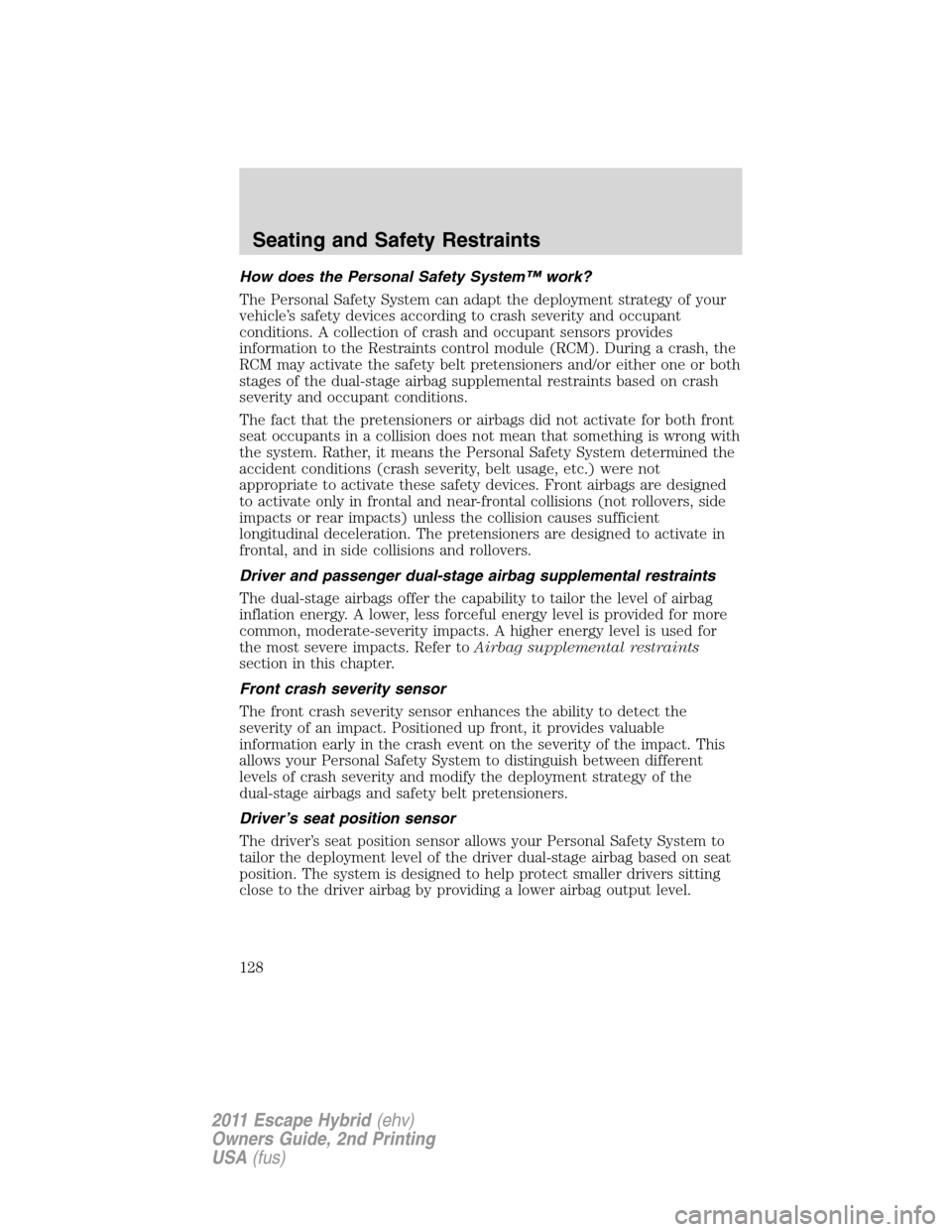
How does the Personal Safety System™ work?
The Personal Safety System can adapt the deployment strategy of your
vehicle’s safety devices according to crash severity and occupant
conditions. A collection of crash and occupant sensors provides
information to the Restraints control module (RCM). During a crash, the
RCM may activate the safety belt pretensioners and/or either one or both
stages of the dual-stage airbag supplemental restraints based on crash
severity and occupant conditions.
The fact that the pretensioners or airbags did not activate for both front
seat occupants in a collision does not mean that something is wrong with
the system. Rather, it means the Personal Safety System determined the
accident conditions (crash severity, belt usage, etc.) were not
appropriate to activate these safety devices. Front airbags are designed
to activate only in frontal and near-frontal collisions (not rollovers, side
impacts or rear impacts) unless the collision causes sufficient
longitudinal deceleration. The pretensioners are designed to activate in
frontal, and in side collisions and rollovers.
Driver and passenger dual-stage airbag supplemental restraints
The dual-stage airbags offer the capability to tailor the level of airbag
inflation energy. A lower, less forceful energy level is provided for more
common, moderate-severity impacts. A higher energy level is used for
the most severe impacts. Refer toAirbag supplemental restraints
section in this chapter.
Front crash severity sensor
The front crash severity sensor enhances the ability to detect the
severity of an impact. Positioned up front, it provides valuable
information early in the crash event on the severity of the impact. This
allows your Personal Safety System to distinguish between different
levels of crash severity and modify the deployment strategy of the
dual-stage airbags and safety belt pretensioners.
Driver’s seat position sensor
The driver’s seat position sensor allows your Personal Safety System to
tailor the deployment level of the driver dual-stage airbag based on seat
position. The system is designed to help protect smaller drivers sitting
close to the driver airbag by providing a lower airbag output level.
Seating and Safety Restraints
128
2011 Escape Hybrid(ehv)
Owners Guide, 2nd Printing
USA(fus)
Page 129 of 363
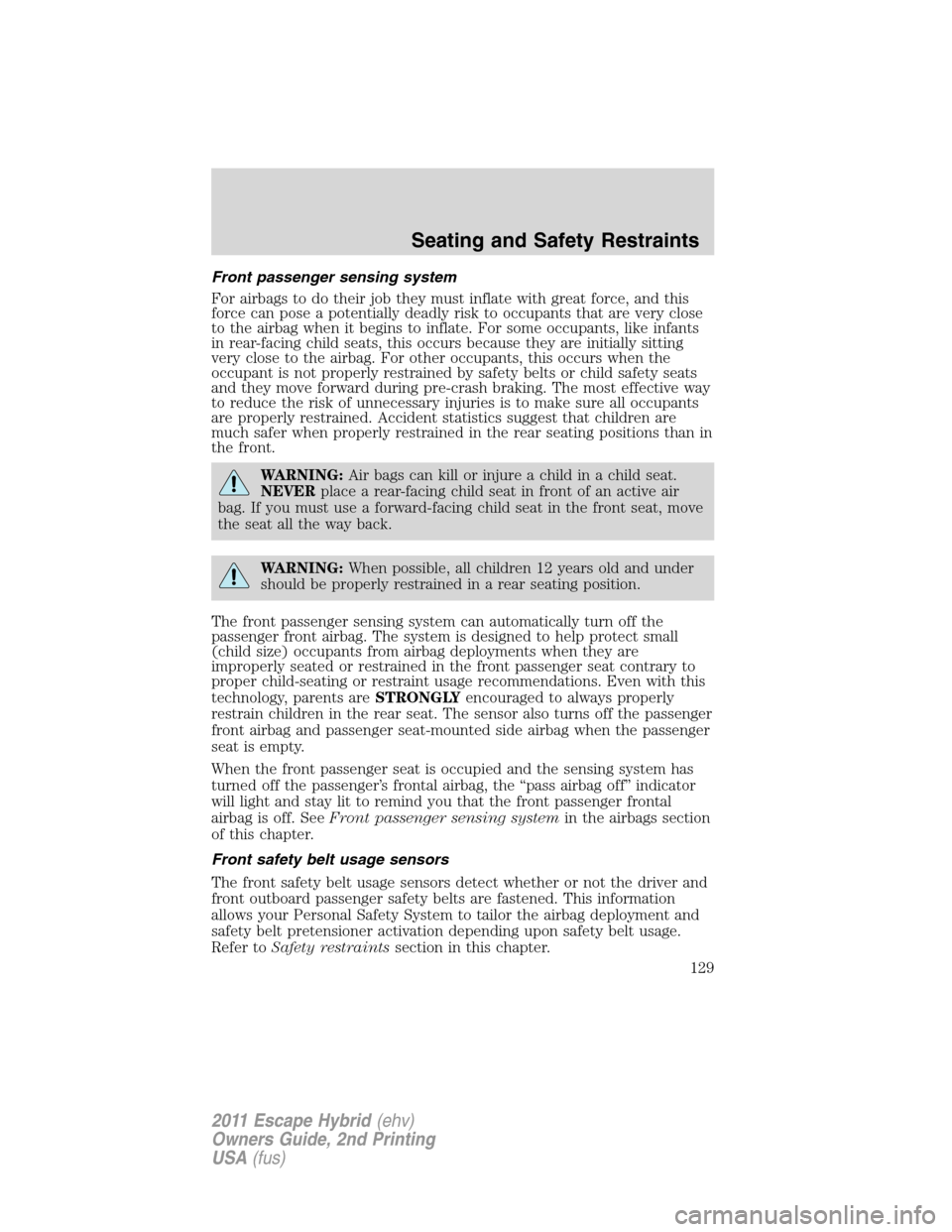
Front passenger sensing system
For airbags to do their job they must inflate with great force, and this
force can pose a potentially deadly risk to occupants that are very close
to the airbag when it begins to inflate. For some occupants, like infants
in rear-facing child seats, this occurs because they are initially sitting
very close to the airbag. For other occupants, this occurs when the
occupant is not properly restrained by safety belts or child safety seats
and they move forward during pre-crash braking. The most effective way
to reduce the risk of unnecessary injuries is to make sure all occupants
are properly restrained. Accident statistics suggest that children are
much safer when properly restrained in the rear seating positions than in
the front.
WARNING:Air bags can kill or injure a child in a child seat.
NEVERplace a rear-facing child seat in front of an active air
bag. If you must use a forward-facing child seat in the front seat, move
the seat all the way back.
WARNING:When possible, all children 12 years old and under
should be properly restrained in a rear seating position.
The front passenger sensing system can automatically turn off the
passenger front airbag. The system is designed to help protect small
(child size) occupants from airbag deployments when they are
improperly seated or restrained in the front passenger seat contrary to
proper child-seating or restraint usage recommendations. Even with this
technology, parents areSTRONGLYencouraged to always properly
restrain children in the rear seat. The sensor also turns off the passenger
front airbag and passenger seat-mounted side airbag when the passenger
seat is empty.
When the front passenger seat is occupied and the sensing system has
turned off the passenger’s frontal airbag, the “pass airbag off” indicator
will light and stay lit to remind you that the front passenger frontal
airbag is off. SeeFront passenger sensing systemin the airbags section
of this chapter.
Front safety belt usage sensors
The front safety belt usage sensors detect whether or not the driver and
front outboard passenger safety belts are fastened. This information
allows your Personal Safety System to tailor the airbag deployment and
safety belt pretensioner activation depending upon safety belt usage.
Refer toSafety restraintssection in this chapter.
Seating and Safety Restraints
129
2011 Escape Hybrid(ehv)
Owners Guide, 2nd Printing
USA(fus)
Page 130 of 363
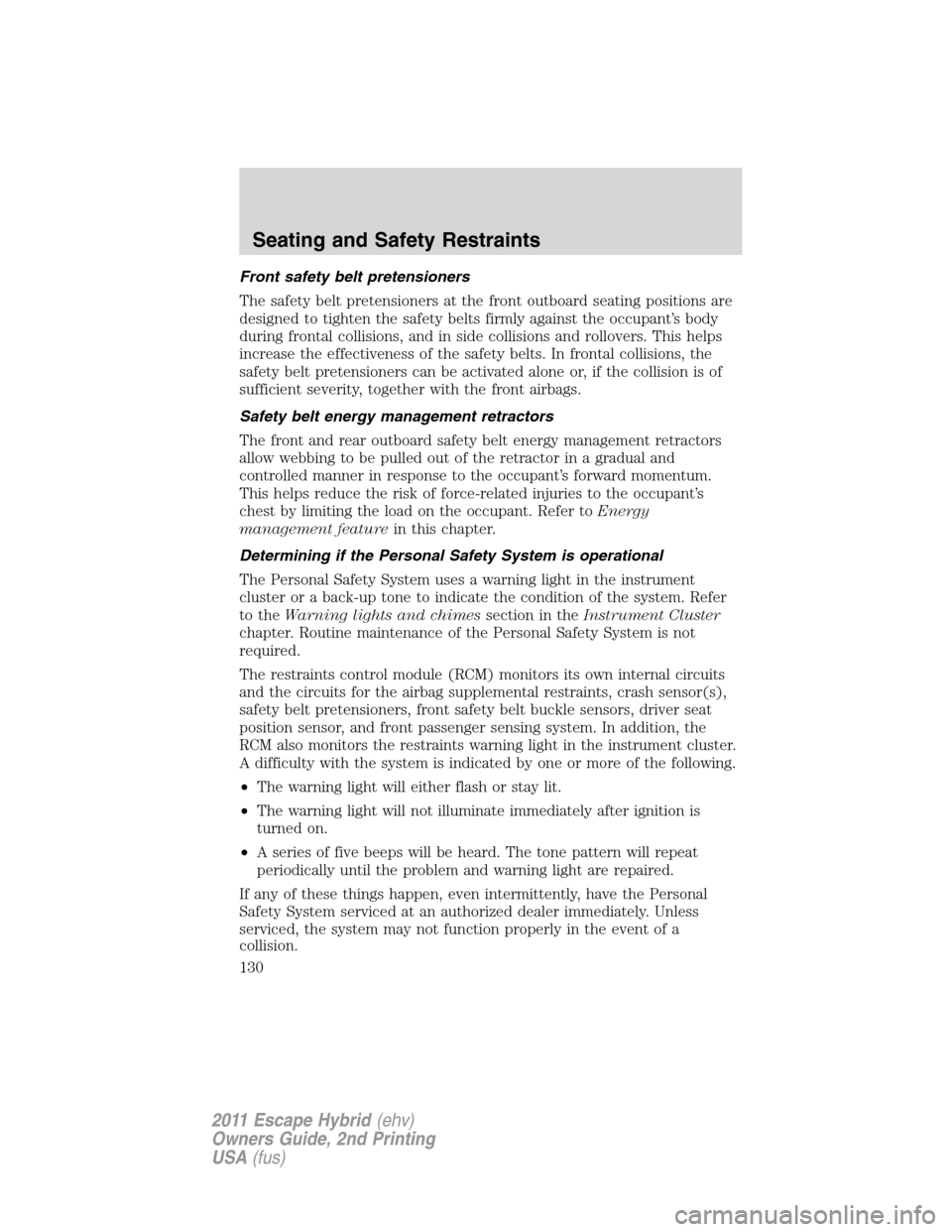
Front safety belt pretensioners
The safety belt pretensioners at the front outboard seating positions are
designed to tighten the safety belts firmly against the occupant’s body
during frontal collisions, and in side collisions and rollovers. This helps
increase the effectiveness of the safety belts. In frontal collisions, the
safety belt pretensioners can be activated alone or, if the collision is of
sufficient severity, together with the front airbags.
Safety belt energy management retractors
The front and rear outboard safety belt energy management retractors
allow webbing to be pulled out of the retractor in a gradual and
controlled manner in response to the occupant’s forward momentum.
This helps reduce the risk of force-related injuries to the occupant’s
chest by limiting the load on the occupant. Refer toEnergy
management featurein this chapter.
Determining if the Personal Safety System is operational
The Personal Safety System uses a warning light in the instrument
cluster or a back-up tone to indicate the condition of the system. Refer
to theWarning lights and chimessection in theInstrument Cluster
chapter. Routine maintenance of the Personal Safety System is not
required.
The restraints control module (RCM) monitors its own internal circuits
and the circuits for the airbag supplemental restraints, crash sensor(s),
safety belt pretensioners, front safety belt buckle sensors, driver seat
position sensor, and front passenger sensing system. In addition, the
RCM also monitors the restraints warning light in the instrument cluster.
A difficulty with the system is indicated by one or more of the following.
•The warning light will either flash or stay lit.
•The warning light will not illuminate immediately after ignition is
turned on.
•A series of five beeps will be heard. The tone pattern will repeat
periodically until the problem and warning light are repaired.
If any of these things happen, even intermittently, have the Personal
Safety System serviced at an authorized dealer immediately. Unless
serviced, the system may not function properly in the event of a
collision.
Seating and Safety Restraints
130
2011 Escape Hybrid(ehv)
Owners Guide, 2nd Printing
USA(fus)